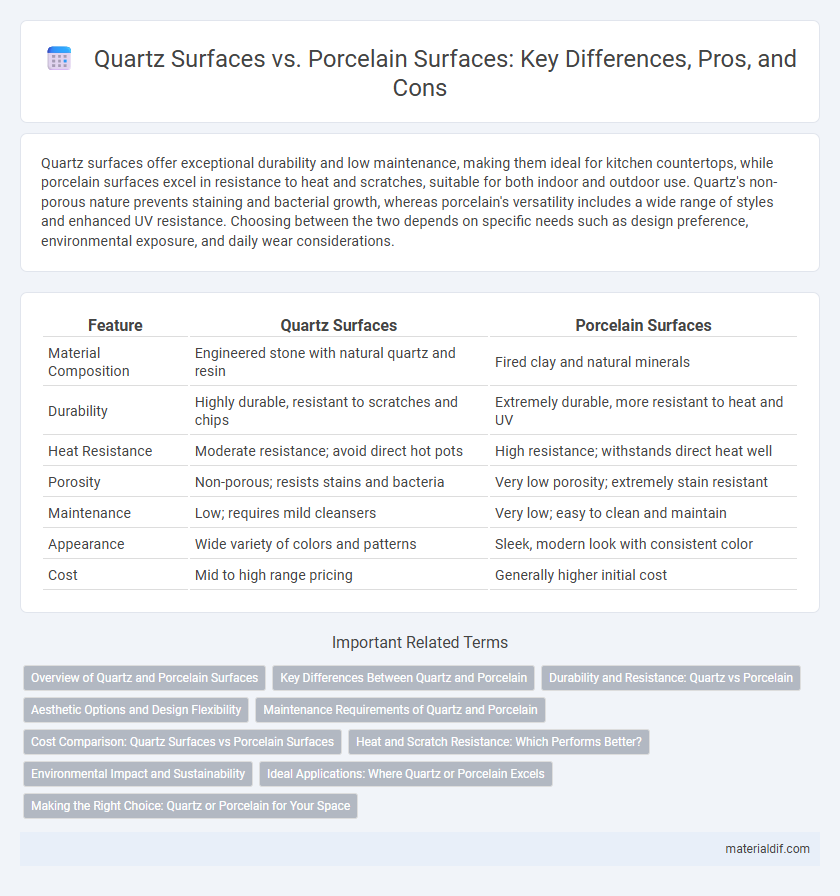Quartz surfaces offer exceptional durability and low maintenance, making them ideal for kitchen countertops, while porcelain surfaces excel in resistance to heat and scratches, suitable for both indoor and outdoor use. Quartz's non-porous nature prevents staining and bacterial growth, whereas porcelain's versatility includes a wide range of styles and enhanced UV resistance. Choosing between the two depends on specific needs such as design preference, environmental exposure, and daily wear considerations.
Table of Comparison
| Feature | Quartz Surfaces | Porcelain Surfaces |
|---|---|---|
| Material Composition | Engineered stone with natural quartz and resin | Fired clay and natural minerals |
| Durability | Highly durable, resistant to scratches and chips | Extremely durable, more resistant to heat and UV |
| Heat Resistance | Moderate resistance; avoid direct hot pots | High resistance; withstands direct heat well |
| Porosity | Non-porous; resists stains and bacteria | Very low porosity; extremely stain resistant |
| Maintenance | Low; requires mild cleansers | Very low; easy to clean and maintain |
| Appearance | Wide variety of colors and patterns | Sleek, modern look with consistent color |
| Cost | Mid to high range pricing | Generally higher initial cost |
Overview of Quartz and Porcelain Surfaces
Quartz surfaces are engineered stone composed of approximately 90% natural quartz combined with resin and pigments, providing high durability, non-porosity, and resistance to stains and scratches. Porcelain surfaces, made from dense, vitrified clay fired at extreme temperatures, offer exceptional hardness, heat resistance, and low water absorption, making them ideal for both indoor and outdoor applications. Both materials provide versatile, low-maintenance options for countertops and flooring, with quartz excelling in uniform aesthetics and porcelain in superior durability and heat tolerance.
Key Differences Between Quartz and Porcelain
Quartz surfaces, composed primarily of engineered stone with natural quartz crystals and resin binders, offer exceptional durability, non-porosity, and a wide range of colors and patterns ideal for countertops. Porcelain surfaces, made from dense ceramic clay fired at high temperatures, excel in heat resistance, scratch resistance, and low water absorption, making them highly suitable for both indoor and outdoor applications. The key differences lie in their material composition, maintenance needs--quartz requiring gentle cleaning due to resin susceptibility to heat, while porcelain withstands more intense wear--and the design versatility quartz provides versus porcelain's superior hardness and UV resistance.
Durability and Resistance: Quartz vs Porcelain
Quartz surfaces offer superior durability and resistance to scratches, stains, and heat due to their engineered composition of natural quartz crystals and resin binders. Porcelain surfaces excel in resistance to high temperatures and extreme impact, making them ideal for heavy-duty applications but can be more prone to chipping under sharp impacts compared to quartz. Both materials are highly durable, but quartz provides enhanced overall resilience for everyday kitchen and bathroom use.
Aesthetic Options and Design Flexibility
Quartz surfaces offer a wide range of colors and patterns, including natural stone looks and vibrant, consistent hues, providing extensive design flexibility for modern and traditional spaces. Porcelain surfaces excel in mimicking natural materials like marble and wood with realistic textures, while offering superior durability and stain resistance. Both materials allow customization for countertops, backsplashes, and flooring, but quartz's engineered composition enables more uniform designs, whereas porcelain offers larger slab options for seamless installations.
Maintenance Requirements of Quartz and Porcelain
Quartz surfaces require minimal maintenance, needing only regular cleaning with mild soap and water to prevent stains and preserve their glossy finish. Porcelain surfaces are highly durable and resistant to scratches, stains, and heat, also requiring simple cleaning without sealing or special treatments. Both materials offer low-maintenance options, but quartz demands slightly more attention to avoid damage from harsh chemicals and high heat.
Cost Comparison: Quartz Surfaces vs Porcelain Surfaces
Quartz surfaces typically cost between $50 and $150 per square foot, reflecting their durability and low maintenance requirements. Porcelain surfaces generally fall in a similar price range, from $40 to $100 per square foot, often making them a more budget-friendly option for large projects. Installation costs for porcelain may be higher due to its hardness, which requires specialized tools and labor.
Heat and Scratch Resistance: Which Performs Better?
Quartz surfaces exhibit excellent scratch resistance due to their engineered composition of natural quartz crystals and resins, providing durability in high-traffic areas. Porcelain surfaces, fired at extremely high temperatures, offer superior heat resistance, withstanding heat exposure that can damage quartz resins. For kitchens requiring strong scratch resistance, quartz is preferred, while porcelain is ideal for environments demanding higher heat tolerance.
Environmental Impact and Sustainability
Quartz surfaces, often composed of around 90% natural quartz combined with resin, have a lower environmental impact compared to traditional stone but involve significant energy consumption during manufacturing. Porcelain surfaces are made from natural clay and minerals, fired at extremely high temperatures, resulting in a durable product with excellent recyclability and lower water absorption rates, contributing to long-term sustainability. Both materials offer eco-friendly benefits, yet porcelain's natural composition and recyclability make it a more sustainable choice in reducing environmental footprints.
Ideal Applications: Where Quartz or Porcelain Excels
Quartz surfaces excel in kitchen countertops and bathroom vanities due to their non-porous nature, durability, and resistance to stains and scratches. Porcelain surfaces are ideal for outdoor applications, high-traffic flooring, and wall cladding because of their superior hardness, UV resistance, and minimal water absorption. Both materials offer unique benefits: quartz is preferred for interior spaces requiring heat resistance and easy maintenance, while porcelain suits environments needing extreme durability and weather resistance.
Making the Right Choice: Quartz or Porcelain for Your Space
Quartz surfaces offer exceptional durability and stain resistance, making them ideal for high-traffic kitchen countertops and bathrooms. Porcelain surfaces provide superior heat resistance and minimal maintenance, suited for both indoor and outdoor applications such as flooring and wall cladding. Selecting between quartz and porcelain depends on the specific needs of your space, balancing factors like aesthetics, durability, and usage intensity.
Quartz Surfaces vs Porcelain Surfaces Infographic

 materialdif.com
materialdif.com